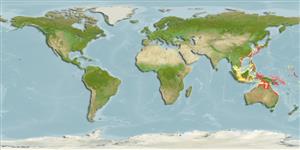Common names from other countries
Environment: milieu / climate zone / depth range / distribution range
Ecología
marino; agua dulce; salobre demersal; catadromo (Ref. 46888). Tropical
Distribución
Países | Áreas FAO | Ecosistemas | Ocurrencias, apariciones | Point map | Introducciones | Faunafri
Western Pacific: endemic to Australia.
Tamaño / Peso / Age
Maturity: Lm ? range ? - ? cm
Max length : 30.0 cm TL macho / no sexado; (Ref. 9812)
Espinas dorsales (total) : 4; Espinas anales: 3; Radios blandos anales: 9. Greenish brown dorsally; flanks silvery; abdomen off white (Ref. 9812). Gold spots on dorsal and ventral parts of iris (Ref. 9812). Second dorsal, anal, and caudal fins with dusky margins and second dorsal speckled brown (Ref. 9812). Pectoral fin with purplish spot dorsally at origin (Ref. 9812).
Form schools in coastal waters, estuaries, and bays; young may enter freshwater. Oviparous, eggs are pelagic and non-adhesive (Ref. 205). Taken as bycatch; used as baitfish for crabs and snappers.
Life cycle and mating behavior
Maturities | Reproducción | Spawnings | Egg(s) | Fecundities | Larva
Harrison, I.J. and H. Senou, 1997. Order Mugiliformes. Mugilidae. Mullets. p. 2069-2108. In K.E. Carpenter and V.H. Niem (eds.) FAO species identification guide for fishery purposes. The living marine resources of the Western Central Pacific. Volume 4. Bony fishes part 2 (Mugilidae to Carangidae). FAO, Rome. (Ref. 9812)
IUCN Red List Status (Ref. 130435)
CITES (Ref. 128078)
Not Evaluated
Threat to humans
Harmless
Human uses
Carnada: occasionally
Herramientas
Special reports
Download XML
Fuentes de Internet
Estimates based on models
Preferred temperature (Ref.
115969): 24.3 - 28.3, mean 27.4 (based on 264 cells).
Phylogenetic diversity index (Ref.
82804): PD
50 = 0.7500 [Uniqueness, from 0.5 = low to 2.0 = high].
Bayesian length-weight: a=0.01175 (0.00558 - 0.02474), b=2.96 (2.79 - 3.13), in cm Total Length, based on LWR estimates for this (Sub)family-body shape (Ref.
93245).
Nivel trófico (Ref.
69278): 2.5 ±0.2 se; based on size and trophs of closest relatives
Resiliencia (Ref.
120179): Medio, población duplicada en un tiempo mínimo de 1.4-4.4 años (Preliminary K or Fecundity.).
Fishing Vulnerability (Ref.
59153): Low vulnerability (20 of 100).
